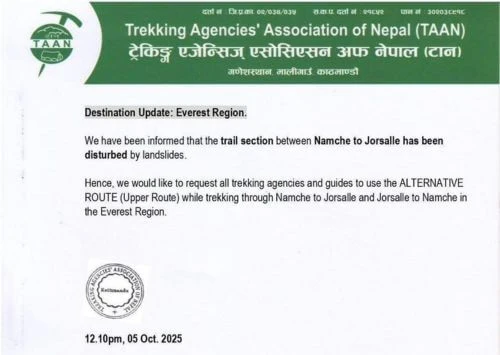The Reason Behind Lukla's Flight Diversion to Ramechhap.
Have you ever wondered why Lukla flights are diverted to Ramechhap instead of Kathmandu? This article explains the reasons behind this decision.
If you're planning a trek to Everest Base Camp, you may have heard that flights to Lukla are sometimes diverted to Ramechhap instead of Kathmandu. But why does this happen? There are several reasons behind this decision, including safety concerns and airport congestion.
During the peak trekking season, Lukla Airport can become congested, and flights are frequently delayed or cancelled due to poor weather conditions. In such cases, airlines may decide to divert flights to Ramechhap, which has a longer runway and is located at a lower altitude, making it safer for planes to land and take off.

Lukla Airport's Location and Weather Conditions.
Lukla Airport is located in the Himalayas and is known for its challenging terrain and unpredictable weather conditions. The airport is situated at an altitude of 2,860 meters and has a short runway that is only 527 meters long. This makes it one of the most dangerous airports in the world. The weather in the Himalayas can be unpredictable, with frequent fog, rain, and snow. These conditions can make it difficult for pilots to land and take off safely. As a result, flights to Lukla are sometimes diverted to Ramechhap, which is located about 132 kilometers from Kathmandu.
The weather conditions in the region are also highly variable, with strong winds, fog, and cloud cover common during certain times of the year. During the monsoon season, which runs from June to September, the airport can be particularly hazardous due to heavy rainfall and low visibility.
Despite these challenges, Lukla Airport is an essential gateway for trekkers and mountaineers looking to explore the Everest Region. The airport's location offers stunning views of the Himalayan mountain range and is a critical entry point for climbers attempting to summit Mount Everest.
In recent years, the Nepalese government has made efforts to improve safety conditions at Lukla Airport, including extending the runway and improving the airport's navigation and communication systems. These upgrades have helped to make the airport safer and more accessible to travelers while still maintaining its unique character as one of the world's most challenging airports.

Limited capacity of Kathmandu Airport.
Kathmandu's Tribhuvan International Airport (TIA) is the only international airport in Nepal, and it serves as a crucial gateway for tourists and business travelers entering the country. However, the airport has limited capacity, which can result in significant challenges for airlines and passengers.
One of the primary limitations of the airport is its single runway, which can only handle a limited number of flights per day. During peak seasons, such as the traveling season from September to November and the spring season from March to May, the airport can become congested, resulting in flight delays and cancellations.
The airport's terminal building is also relatively small, which can cause overcrowding and long wait times for passengers. This is especially problematic during peak travel seasons, when the number of travelers can far exceed the airport's capacity.
One of the main reasons why Lukla flights are diverted to Ramechhap instead of Kathmandu is due to the limited capacity of the Kathmandu Airport. The airport can only handle a certain number of flights per day, and during peak trekking season, the number of flights to Lukla increases significantly. This can lead to congestion and delays at the airport, which is why flights are sometimes diverted to Ramechhap. Additionally, Ramechhap Airport has been upgraded in recent years to handle more flights and passengers, making it a viable alternative to Kathmandu.
Ramechhap Airport's proximity to Kathmandu.
Ramechhap Airport is located approximately 132 kilometers east of Kathmandu, making it a relatively close alternative for Lukla flights. While it may add some extra travel time for trekkers, it allows for a smoother and more efficient process for flights and reduces congestion at the Kathmandu Airport. Additionally, Ramechhap Airport is located at a lower altitude than Lukla, which can be beneficial for flights during inclement weather conditions.
In fact, Ramechhap Airport has become an important alternative to TIA, particularly during peak travel seasons when TIA can become congested and flights are frequently delayed or cancelled due to poor weather conditions. Many airlines that operate flights to Lukla, which is a popular destination for trekkers and mountaineers, use Ramechhap Airport as a backup option, and passengers are often transported to and from Kathmandu via bus or private vehicle.

Government's Efforts to Improve Lukla Airport.
The Nepalese Government has been working to improve the infrastructure and safety measures at Lukla Airport, which is known for its challenging terrain and unpredictable weather conditions. In recent years, the runway has been extended and widened, and new navigational equipment has been installed to improve visibility for pilots. These efforts aim to make Lukla airport a safer and more reliable option for trekkers and climbers visiting the Everest Region.
- Runway Extension: The Nepalese government has extended the runway length by 200 meters, making it possible for larger planes to land and take off. This extension has also increased the safety margin for planes landing and taking off.
- Safety Upgrades: The government has installed a radar system and an Instrument Landing System (ILS) to improve safety during landing and takeoff. These systems help pilots navigate the challenging terrain and ensure a safe landing.
- Terminal Expansion: The government has also expanded the terminal building to accommodate more passengers and improve the overall airport experience. This expansion has also improved the handling of baggage and cargo.
- Better Training and Monitoring: The government has increased the training and monitoring of airport staff to ensure that they are competent and capable of handling the demands of the airport.
- Environmental Sustainability: The government has also taken steps to make the airport more environmentally sustainable. They have installed solar panels to reduce reliance on fossil fuels and implemented measures to reduce waste and pollution.
Tips for Travelers to Prepare for the Lukla Flight Diversion.
If you are planning a trek or climb in the Everest Region, it’s important to be prepared for the possibility of your Lukla flight being diverted to Ramechhap. Here are some tips to help you prepare: Pack extra snacks and water in case of delays, bring warm clothing as Lukla is at a higher altitude and can be colder than Ramechhap, and you can also consider booking a private jeep or helicopter transfer from Ramechhap to Kathmandu to avoid the long bus ride. It’s also important to stay informed about weather conditions and flight updates and to have a flexible itinerary in case of unexpected changes.
- Pack essential items in your carry-on luggage: In the event of a flight diversion, your checked luggage may not arrive with you at your final destination. It is important to pack essential items such as warm clothing, medication, and toiletries in your carry-on luggage.
- Check the weather forecast: Lukla is located in the Himalayas, and weather conditions can change quickly. Before your flight, check the weather forecast and be prepared for the possibility of a flight diversion due to poor weather conditions.
- Be flexible with your itinerary: If your flight is diverted to Ramechhap, it may take several hours to travel to Lukla by road. This may impact your itinerary, so it is important to be flexible with your plans.
- Bring extra cash: If your flight is diverted, you may need to pay for additional transportation or accommodations. It is a good idea to bring extra cash in case of any unforeseen expenses.
- Stay informed: Keep in touch with your airline and tour operator for updates on your flight status and any changes to your itinerary. Be sure to provide them with your contact information so they can reach you in case of any changes.
- Stay calm and be patient: Flight diversions can be stressful, but it is important to stay calm and be patient. Follow instructions from airline staff and remain flexible with your plans. Remember that safety is the top priority, and your airline will do everything possible to ensure your safe arrival at your destination.
In addition, Ramechhap Airport has been developed as an alternative airport for Lukla, and it is equipped with modern facilities to handle large numbers of passengers. This has made it a popular choice for airlines that operate flights to Lukla, especially during the busy trekking season.
In summary, flights to Lukla are often diverted to Ramechhap due to safety concerns and poor weather conditions. The airport is equipped with modern facilities, making it a convenient alternative for airlines and passengers.





